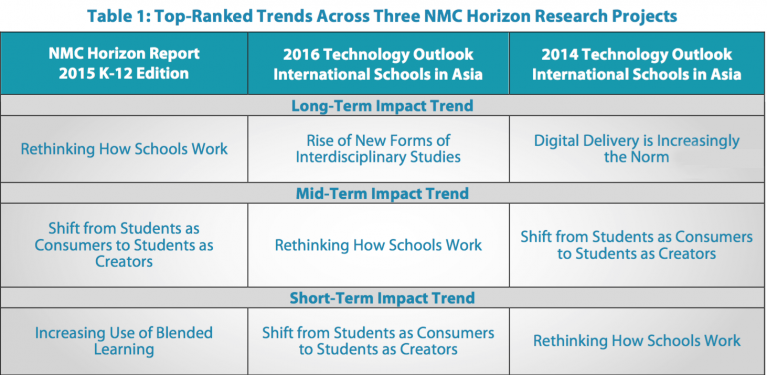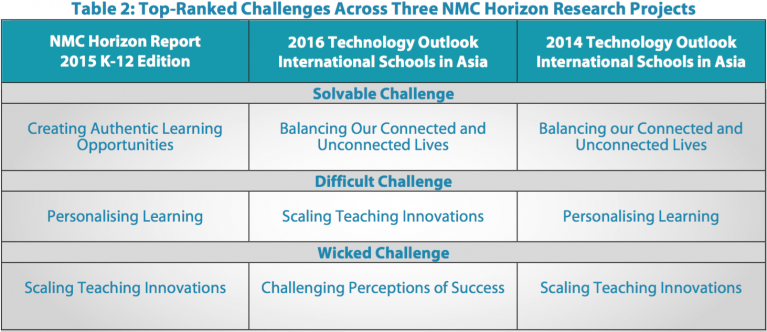Another year another Horizon Report for International Schools in Asia.
Lucky me. Once again, along with my good friend Ivan Beeckmans of NIST, I was a co-editor of the Horizon Report for International Schools in Asia. This meant we worked together to recruit a team of individuals and organizations who wished to be a part of the research process. This commitment is financial as well, so thank you for all your support.
The report provides international school leaders and practitioners with in-depth insight into how trends and challenges are accelerating and impeding the adoption of educational technology, along with their implications for policy, leadership, and practice.
What Is The Horizon Report?
If you are not familiar with the report, NMC, parent group of the Horizon Report, explains it this way: “The report identifies nine key trends, nine significant challenges, and twelve important developments in educational technology across three adoption horizons spanning the next one to five years, giving school leaders, educational technologists, and teachers a valuable guide for strategic technology planning. The report provides international school leaders and practitioners with in-depth insight into how trends and challenges are accelerating and impeding the adoption of educational technology, along with their implications for policy, leadership, and practice.”
Our Findings
The report is very comprehensive; more than I can discuss in a “short” blog post. To keep it light, I am focused on just two areas: trends and troubles (challenges)
To see it all, feel free to download a copy of the report.
Schools are conservative by nature, so change is usually incremental.
Trends
The first table shows the trends we found in our Asian international schools. You can see similarities with the larger, K-12 report that describes schools in the United States and our areas of emphasis. This includes our previous report that was released at the end of 2014.

I agree with what we found. I know the discussion of pushing students to become creators over consumers has been going on for a while and it is good to see it become a short term trend. It also begs the question of rethinking how schools work. While that idea is still ongoing, we only see it happening at the margins of various schools as they pilot some new programs and ideas. Schools are conservative by nature, so change is usually incremental.
However, there may simply be a new standard or benchmark from which we must define balance
Challenges

For some strange reason, the challenges are often the most interesting for me. I like to try and solve problems and knowing where I should put my energies is very helpful.
As you can see, “Balancing our Connected and Unconnected Lives” is once again considered a solvable problem. As my current school brings a renewed focus on social and emotional learning, we should continue to think about this. However, there may simply be a new standard or benchmark from which we must define balance.
From a technical point of view, scaling success is not as hard anymore and may soon not be seen as a problem. Moving so much to the cloud as enabled scale, but I think this report refers to scaling great ideas within a school to the remainder of the school. For example, my wife Lori who serves on the board of Special Education Network in Asia (SENIA) enjoyed the focus on executive function and our students. How, though, should she scale these new, sound practices to all levels? Like a doctor learning of a new protocol for delivering medical services, education is also learning new ways of delivery.
I love that “Challenging Perceptions of Success” is seen as a wicked problem. As you may know, we tend to manage what we measure. An AP or IB teacher is going to measure their teaching practices, in part, based on how well their students do on standardized test scores. In fact, that is often what our parents demand. How do we challenge this? Not allow external exams to be our main guide? In the United States it is much worse, in Finland where they have nearly zero standardized tests, it is much better.
Final Thoughts
If you and/or your organization decide to leverage the research of this report to encourage change, thank you! I know I will and having a document with this much weight behind it is a tremendous boost to our arguments and ideas as we move educational practices forward.
